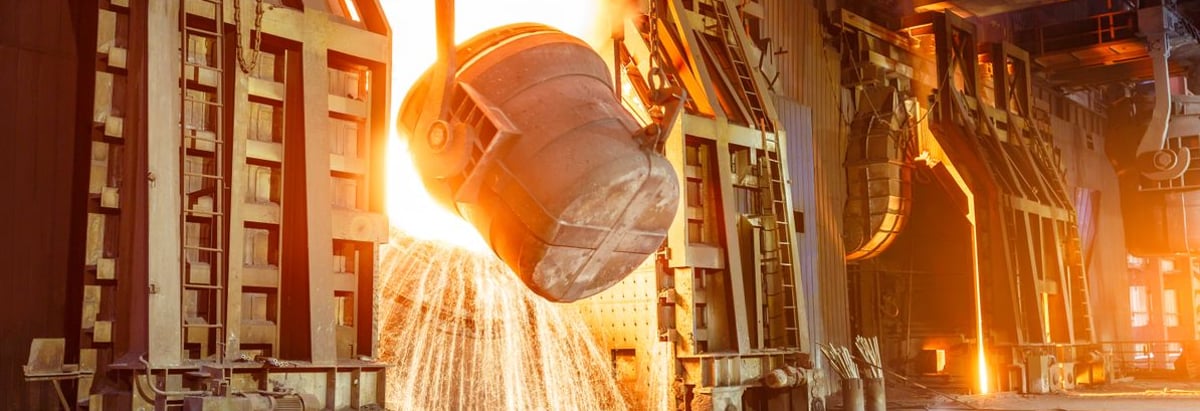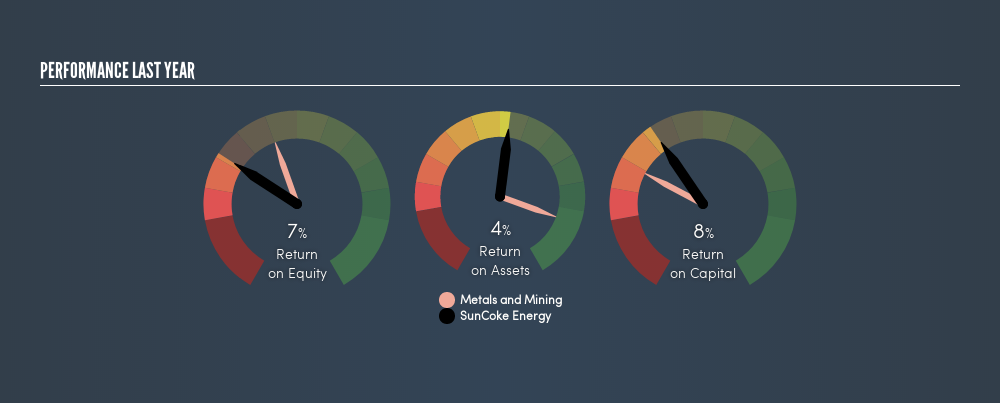- United States
- /
- Metals and Mining
- /
- NYSE:SXC
Why We’re Not Impressed By SunCoke Energy, Inc.’s (NYSE:SXC) 7.9% ROCE

Today we'll look at SunCoke Energy, Inc. (NYSE:SXC) and reflect on its potential as an investment. Specifically, we'll consider its Return On Capital Employed (ROCE), since that will give us an insight into how efficiently the business can generate profits from the capital it requires.
First, we'll go over how we calculate ROCE. Second, we'll look at its ROCE compared to similar companies. And finally, we'll look at how its current liabilities are impacting its ROCE.
Return On Capital Employed (ROCE): What is it?
ROCE is a metric for evaluating how much pre-tax income (in percentage terms) a company earns on the capital invested in its business. All else being equal, a better business will have a higher ROCE. Ultimately, it is a useful but imperfect metric. Renowned investment researcher Michael Mauboussin has suggested that a high ROCE can indicate that 'one dollar invested in the company generates value of more than one dollar'.
So, How Do We Calculate ROCE?
The formula for calculating the return on capital employed is:
Return on Capital Employed = Earnings Before Interest and Tax (EBIT) ÷ (Total Assets - Current Liabilities)
Or for SunCoke Energy:
0.079 = US$148m ÷ (US$2.0b - US$171m) (Based on the trailing twelve months to December 2018.)
Therefore, SunCoke Energy has an ROCE of 7.9%.
See our latest analysis for SunCoke Energy
Does SunCoke Energy Have A Good ROCE?
ROCE can be useful when making comparisons, such as between similar companies. We can see SunCoke Energy's ROCE is meaningfully below the Metals and Mining industry average of 11%. This performance is not ideal, as it suggests the company may not be deploying its capital as effectively as some competitors. Aside from the industry comparison, SunCoke Energy's ROCE is mediocre in absolute terms, considering the risk of investing in stocks versus the safety of a bank account. It is possible that there are more rewarding investments out there.
As we can see, SunCoke Energy currently has an ROCE of 7.9% compared to its ROCE 3 years ago, which was 4.5%. This makes us think about whether the company has been reinvesting shrewdly.

When considering this metric, keep in mind that it is backwards looking, and not necessarily predictive. Companies in cyclical industries can be difficult to understand using ROCE, as returns typically look high during boom times, and low during busts. ROCE is, after all, simply a snap shot of a single year. Given the industry it operates in, SunCoke Energy could be considered cyclical. What happens in the future is pretty important for investors, so we have prepared a freereport on analyst forecasts for SunCoke Energy.
Do SunCoke Energy's Current Liabilities Skew Its ROCE?
Short term (or current) liabilities, are things like supplier invoices, overdrafts, or tax bills that need to be paid within 12 months. The ROCE equation subtracts current liabilities from capital employed, so a company with a lot of current liabilities appears to have less capital employed, and a higher ROCE than otherwise. To counteract this, we check if a company has high current liabilities, relative to its total assets.
SunCoke Energy has total liabilities of US$171m and total assets of US$2.0b. Therefore its current liabilities are equivalent to approximately 8.4% of its total assets. With low levels of current liabilities, at least SunCoke Energy's mediocre ROCE is not unduly boosted.
Our Take On SunCoke Energy's ROCE
If performance improves, then SunCoke Energy may be an OK investment, especially at the right valuation. You might be able to find a better buy than SunCoke Energy. If you want a selection of possible winners, check out this freelist of interesting companies that trade on a P/E below 20 (but have proven they can grow earnings).
If you are like me, then you will not want to miss this freelist of growing companies that insiders are buying.
We aim to bring you long-term focused research analysis driven by fundamental data. Note that our analysis may not factor in the latest price-sensitive company announcements or qualitative material.
If you spot an error that warrants correction, please contact the editor at editorial-team@simplywallst.com. This article by Simply Wall St is general in nature. It does not constitute a recommendation to buy or sell any stock, and does not take account of your objectives, or your financial situation. Simply Wall St has no position in the stocks mentioned. Thank you for reading.
About NYSE:SXC
SunCoke Energy
Operates as an independent producer of coke in the Americas and Brazil.
Undervalued with solid track record and pays a dividend.
Similar Companies
Market Insights
Community Narratives





